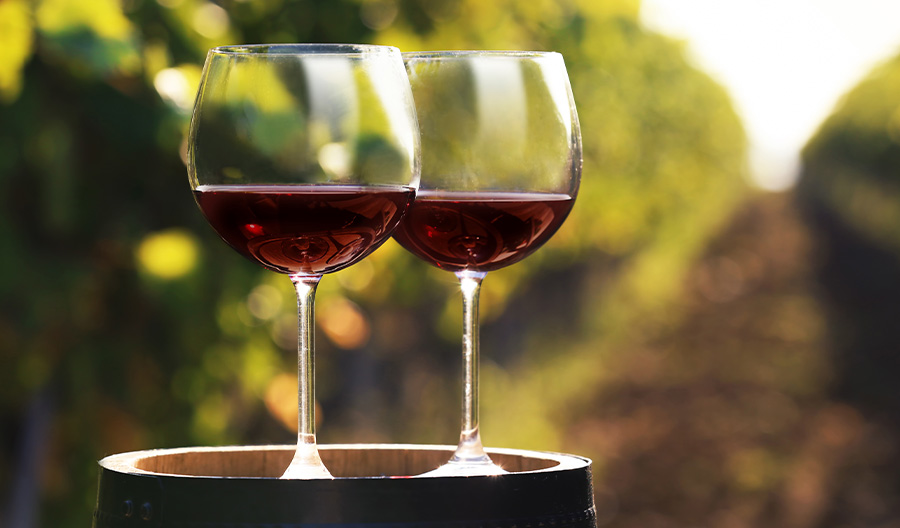Beaujolais is a wine-producing region in France, located in the southern part of Burgundy, and is made from the Gamay grape, which is known for its light, fruity characteristics. There are 12 different appellations within the Beaujolais region, each producing a unique style of wine. Beaujolais is also known for its unique winemaking process. The region is famous for a technique called 'carbonic maceration', which is a whole-berry anaerobic fermentation that emphasizes fruit flavors over tannins. This process gives Beaujolais wines their signature fresh, vibrant, and juicy taste.
Beaujolais wines are also categorized into three main quality levels: Beaujolais, Beaujolais-Villages, and Cru Beaujolais. Each level is determined by the specific area within the Beaujolais region where the grapes are grown, with Cru Beaujolais representing the highest quality. The most prestigious wines from Beaujolais come from the ten 'crus', which are specific areas with their appellations. Beaujolais Nouveau is a popular style of Beaujolais wine that is released on the third Thursday of November each year. Beaujolais Nouveau is meant to be drunk young, usually within 6 months of its release.
Beaujolais wines typically have lower tannin levels, making them more approachable and easy to drink at a younger age, and are often served slightly chilled, which can enhance their fruity and refreshing qualities. In recent years, there has been a trend towards producing more structured and complex Beaujolais wines, particularly from the crus. Climate change is impacting the Beaujolais region, with warmer temperatures potentially altering the style and character of the wines. Despite its reputation for producing light, easy-drinking wines, Beaujolais also produces some age-worthy wines, particularly from the crus.
Quick Facts about Beaujolais
There are approximately 18,000 hectares of vineyards in Beaujolais.
Beaujolais produces around 13 million cases of wine annually.
The region is home to nearly 2,500 wine producers.
Beaujolais Nouveau represents about 1/3 of the production of Beaujolais wines.
Beaujolais exports approximately 40% of its production.
United States is the largest importer of Beaujolais, followed by Japan.

Current Trends
The Beaujolais wine market is currently experiencing a resurgence in popularity, driven by a renewed interest in lighter, more versatile wines. Beaujolais, known for its fruity and light-bodied reds, is increasingly being recognized for its quality and value.
Consumers, particularly younger ones, are seeking out wines that are more approachable and less intimidating than some traditional heavy reds. This has led to a rise in demand for Beaujolais, which is often seen as a gateway to the broader world of French wines.
Another trend is the growing appreciation for the region's 'Cru Beaujolais' wines. These are the highest tier of Beaujolais wines, coming from ten specific vineyard areas known for their unique terroir. As consumers become more knowledgeable about wine, they are seeking out these more complex and distinctive offerings. Beaujolais Nouveau, the young, fresh wine released just weeks after harvest, has traditionally been a major part of the Beaujolais market.
However, there is a shift towards the more mature and complex Beaujolais and Beaujolais-Villages wines, as consumers look for wines with more depth and longevity. Organic and biodynamic farming practices are also gaining traction in the Beaujolais region. Many producers are moving towards these more sustainable methods, in response to consumer demand for wines that are not only high-quality but also environmentally friendly.
Finally, there is a trend towards direct-to-consumer sales and online marketing. With the rise of e-commerce and social media, Beaujolais producers are finding new ways to reach consumers directly, bypassing traditional distribution channels.
The Future of Beaujolais
The Beaujolais wine industry, like many others, is expected to undergo significant changes in the future due to various factors. Climate change, for instance, is one of the most pressing issues. As global temperatures rise, the Beaujolais region's traditional grape, Gamay, may struggle to thrive. This could push producers to experiment with different grape varieties or adopt innovative viticulture techniques to ensure the survival of the industry.
Another important trend is the growing consumer demand for organic and biodynamic wines. Many Beaujolais producers are already responding to this trend by transitioning to more sustainable farming practices. This not only helps to preserve the environment but also enhances the quality and authenticity of the wines, which are highly valued by today's consumers. Technology is also set to play a crucial role in the future of the Beaujolais wine industry. From precision viticulture and automated harvesting to blockchain technology for traceability, these advancements can help producers increase efficiency, reduce costs, and improve the overall quality of their wines.
The future of the Beaujolais wine industry will also be shaped by shifts in consumer behavior and preferences. The younger generation of wine drinkers, for example, is more adventurous and open to trying wines from lesser-known regions and grape varieties. This presents an opportunity for Beaujolais producers to attract new consumers and expand their market share.

